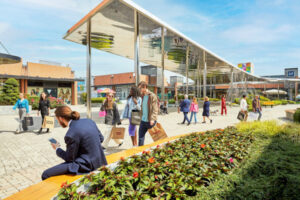More than a year of virtual living has shaped the way we use, design, and transform real estate and ultimately cities. Covid-19 has accelerated several global trends, including flexible working, e-commerce, as well as the need for strong integration and a mix of different real estate functions as mixed-use. The experts at Multi Corporation believe that the future of real estate assets will consist of a combination of physical and digital domains, with social, economic, and environmental factors taking center stage.
Flexibility and mobility are primarily viewed through the way we work and learn, as where we live is largely dictated by where we need to physically commute to for work and education. As major European cities have grown steadily over the past two decades and are projected to continue to grow in the coming years (Oxford Economics, 2021), the combination of urban growth patterns with structurally increasing flexibility and mobility patterns is a critical factor in transforming traditional asset classes into mixed-use destinations. Designing for increasingly mobile and flexible residents, aging populations, and professionals structurally shifts real estate demand for cities as a whole, as well as for different neighborhoods.
Transition of Labor Markets
One catalyst for structural shifts in demand for upgraded building space is the transition of labor markets to a greater share of workers in the information technology and communications, real estate, and knowledge-intensive business services sectors, which varies by country and by city region (Eurostat, 2020). Those sectors contain a larger share of highly skilled professionals who are more likely to work from home, which is an important factor in measuring the demand for high-quality commercial real estate space, both qualitatively and quantitatively. Given the fact that the trend of mobile working is expected to exceed pre-pandemic levels in the near future, there will be different consequences for cities and neighborhoods as people shift more of their time to where they live as opposed to where they work. For labor markets, this means that employees will be able to live much further away from city offices, but that they will also need housing options that easily accommodate mobile working, whether through larger residential units or co-working spaces integrated into co-living or retail locations.
For neighborhoods, this means that commercial real estate functions that were previously only located in city centers can adapt on a smaller scale. This is already evident in the renovation of historic shopping streets in cities such as Amsterdam and London, where retail space is being upgraded with additional residential and office functions to provide a more complete picture of daily life. This idea has also been applied to well-located shopping centers, such as Forum Mülheim, a retail destination in Germany’s Ruhr region, where health-related functions are used to increase the mixed-use character of the retail property. For local areas anchored by a high percentage of college and university students, residential and commercial space is also needed for graduates entering the young professional phase, where employment opportunities can mix with established social networks. Transforming real estate to accommodate more flexible and mobile preferences requires a thorough understanding of population profiles and their respective needs in order to accurately improve daily life.
Physical and Digital Infrastructure
Demographic demand and favorable labor markets have emerged as key mechanisms for improving real estate assets by adding new building features to balance existing retail and services. Another key component of upgrading assets is the surrounding physical and digital infrastructure, which allows for higher building density but also addresses environmental sustainability. Examples include joint European projects, such as the improvement of the train connection between Amsterdam and Berlin (Deutsche Bahn, 2021), highlight the fact that mobility between large knowledge economies will also play a role in real estate demand. Leveraging these physical and digital changes in conjunction with demographic change will be critical to a successful mixed-use real estate strategy that goes beyond combining different asset classes.





